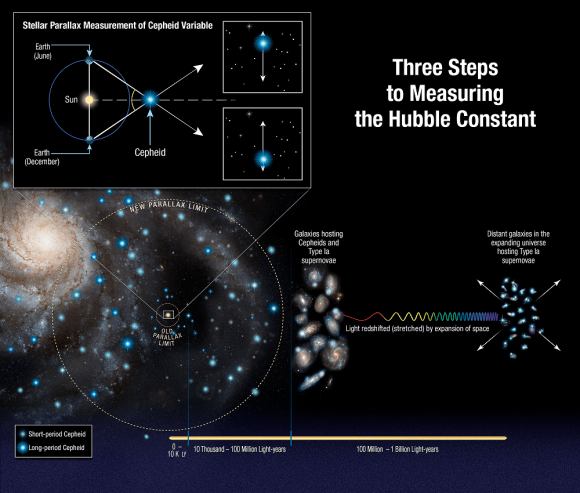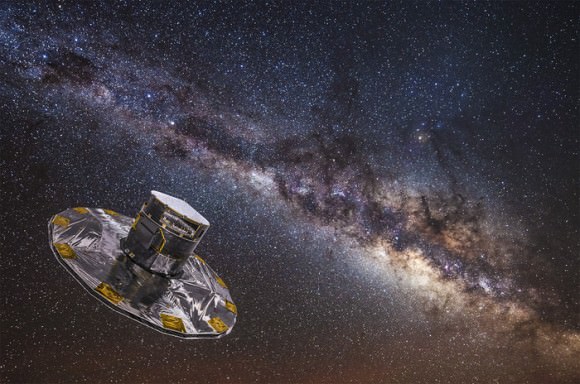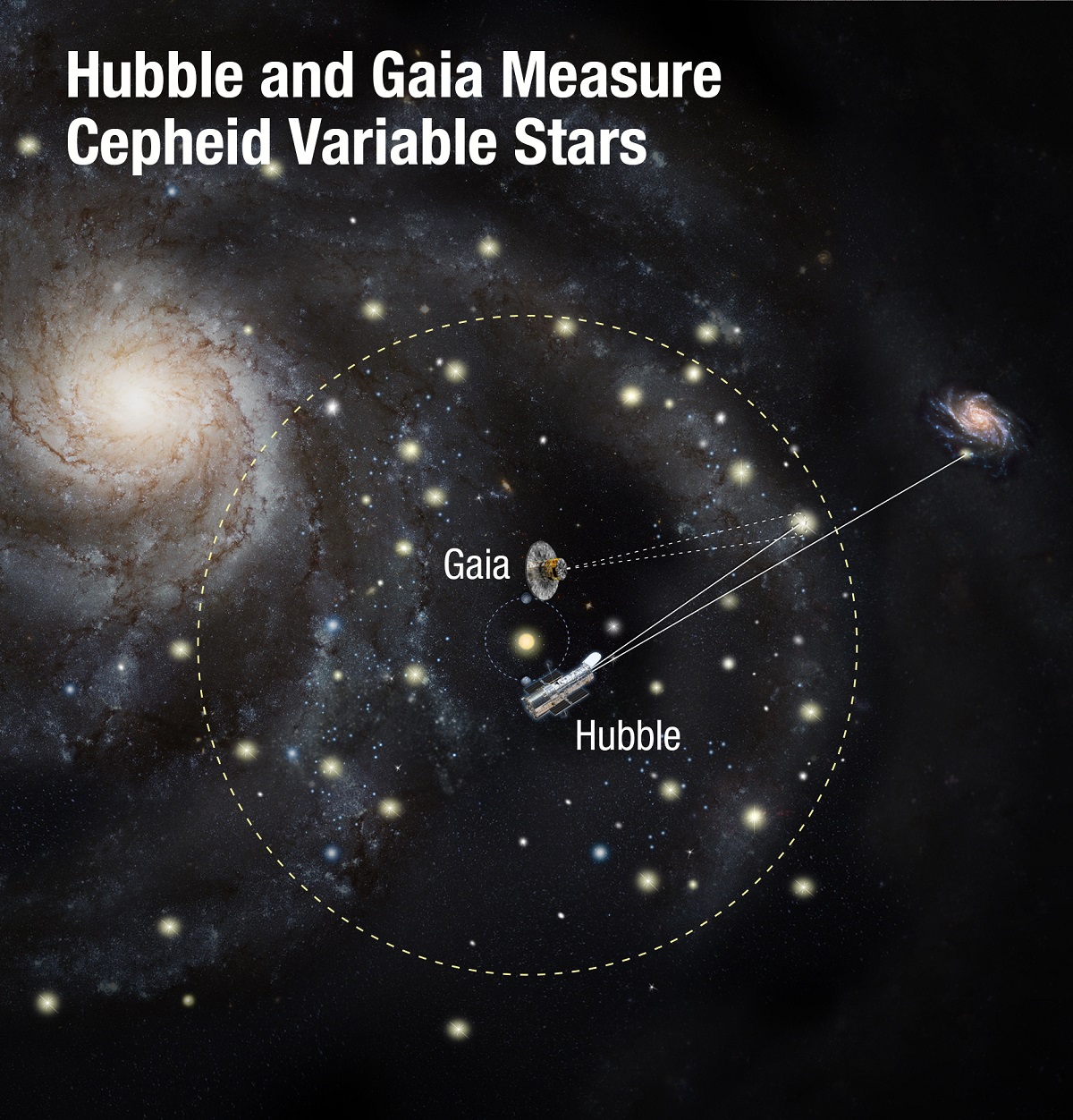In the 1920s, Edwin Hubble made the groundbreaking discovery that the Universe was in a state of expansion. Originally predicted as a consequence of Einstein’s Theory of General Relativity, measurements of this expansion came to be known as Hubble’s Constant. Today, and with the help of next-generation telescopes – like the aptly-named Hubble Space Telescope (HST) – astronomers have remeasured and revised this law many times.
These measurements confirmed that the rate of expansion has increased over time, though scientists are still unsure why. The latest measurements were conducted by an international team using Hubble, who then compared their results with data obtained by the European Space Agency’s (ESA) Gaia observatory. This has led to the most precise measurements of the Hubble Constant to date, though questions about cosmic acceleration remain.
The study which describes their findings appeared in the July 12th issue of the Astrophysical Journal, titled “Milky Way Cepheid Standards for Measuring Cosmic Distances and Application to Gaia DR2: Implications for the Hubble Constant.” The team behind the study included members from the Space Telescope Science Institute (STScI), the Johns Hopkins University, the National Institute for Astrophysics (INAF), UC Berkeley, Texas A&M University, and the European Southern Observatory (ESO).

Since 2005, Adam Riess – a Nobel Laureate Professor with the Space Telescope Science Institute and the Johns Hopkins University – has been working to refine the Hubble Constant value by streamlining and strengthening the “cosmic distance ladder”. Along with his team, known as Supernova H0 for the Equation of State (SH0ES), they have successfully reduced the uncertainty associated with the rate of cosmic expansion to just 2.2%
To break it down, astronomers have traditionally used the “cosmic distance ladder” to measure distances in the Universe. This consists of relying on distance markers like Cepheid variables in distant galaxies – pulsating stars whose distances can be inferred by comparing their intrinsic brightness with their apparent brightness. These measurements are then compared to the way light from distant galaxies is redshifted to determine how fast the space between galaxies is expanding.
From this, the Hubble Constant is derived. Another method that is used is to observe the Cosmic Microwave Background (CMB) to trace the expansion of the cosmos during the early Universe – circa. 378,000 years after the Big Bang – and then using physics to extrapolate that to the present expansion rate. Together, the measurements should provide an end-to-end measurement of how the Universe has expanded over time.
However, astronomers have known for some time that the two measurements don’t match up. In a previous study, Riess and his team conducted measurements using Hubble to obtain a Hubble Constant value of 73 km/s (45.36 mps) per megaparsec (3.3 million light-years). Meanwhile, results based on the ESA’ Planck observatory (which observed the CMB between 2009 and 2013) predicted that the Hubble constant value should now be 67 km/s (41.63 mps) per megaparsec and no higher than 69 km/s (42.87 mps) – which represents a discrepancy of 9%.

As Riess indicated in a recent NASA press release:
“The tension seems to have grown into a full-blown incompatibility between our views of the early and late time universe. At this point, clearly it’s not simply some gross error in any one measurement. It’s as though you predicted how tall a child would become from a growth chart and then found the adult he or she became greatly exceeded the prediction. We are very perplexed.”
In this case, Riess and his colleagues used Hubble to gauge the brightness of distant Cepheid variables while Gaia provided the parallax information – the apparent change in an objects position based on different points of view – needed to determine the distance. Gaia also added to the study by measuring the distance to 50 Cepheid variables in the Milky Way, which were combined with brightness measurements from Hubble.
This allowed the astronomers to more accurately calibrate the Cepheids and then use those seen outside the Milky Way as milepost markers. Using both the Hubble measurements and newly released data from Gaia, Riess and his colleagues were able to refine their measurements on the present rate of expansion to 73.5 kilometers (45.6 miles) per second per megaparsec.

As Stefano Casertano, of the Space Telescope Science Institute and a member of the SHOES team, added:
“Hubble is really amazing as a general-purpose observatory, but Gaia is the new gold standard for calibrating distance. It is purpose-built for measuring parallax—this is what it was designed to do. Gaia brings a new ability to recalibrate all past distance measures, and it seems to confirm our previous work. We get the same answer for the Hubble constant if we replace all previous calibrations of the distance ladder with just the Gaia parallaxes. It’s a crosscheck between two very powerful and precise observatories.”
Looking to the future, Riess and his team hope to continue to work with Gaia so they can reduce the uncertainty associated with the value of the Hubble Constant to just 1% by the early 2020s. In the meantime, the discrepancy between modern rates of expansion and those based on the CMB will continue to be a puzzle to astronomers.
In the end, this may be an indication that other physics are at work in our Universe, that dark matter interacts with normal matter in a way that is different than what scientists suspect, or that dark energy could be even more exotic than previously thought. Whatever the cause, it is clear the Universe still has some surprises in store for us!
Further Reading: NASA

